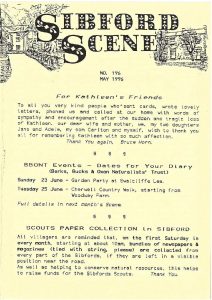A review by a Mere Male
(well, no one else volunteered – so there)
Having been persuaded to buy a ticket for a ‘mannequin parade’ at the Village Hall on 23 March, I wasn’t sure what to expect. Thoughts of ‘period clothes’ to be ‘modelled by local people’ brought visions of sitting among a couple of dozen ladies, watching a few brave village worthies clomping woodenly across the stage in a boring succession of granny‘s old clothes, pausing for an embarrassed, and embarrassing, curtsy before rushing off into the wings. Hearing later that most of the Surgery personnel were to be involved, I thought we might be in for a touch of “Carry On Florence Nightingale”.
I couldn’t have been more wrong! Well before the show started, the Hall was packed to the doors, with every seat taken and many dozens of late-comers lining the walls. Even the hard-worked doorman, Roger Powell (himself a one-man fashion show, sartorially resplendent in yellow check waistcoat and plus twos) lost his official chair in the crush!
An expertly lit and gloriously carpeted eye-level T-shaped cat-walk stretched the length of the Hall and near the stage a dinner-jacketed David Ryall was warming up at the piano. Clearly this was to be no amateurish ‘wham, bam, thank you, mam’ performance. An air of “you ain’t seen nuthin’ yet” pervaded the audience. Our expectations were proved right when the show’s stunningly attired MC, Carol Bower, appeared in the spot-light.
Carol explained that most of the clothes we were to see came from the extensive collections of Susan Heath and Jane Holliday, augmented by items lent or donated by other villagers. The show then started, demurely at first, with ladies & young girls sedately parading in long white Victorian nightdresses, mobcaps & thick bedsocks. My heart sank – was it, after all, to be the ‘Granny’s Old Clothes Show’ that I had feared? But the demureness, and my fears, soon evaporated as a dozen ladies & teenagers began to ‘strut their stuff’ along the cat-walk. displaying, with increasing confidence and to my increasing delight, a succession of more modern (and more revealing) nighties, negligées and cami-thingees.
After a brief pause, (enough time to wipe the steam front my glasses), the show continued, with twenty models presenting a delightful range of daywear from the 30’s to the 60’s, many coordinated with matching shoes, gloves & handbags. Of particular interest were the homemade dresses from the ‘make-do-and-mend’ war years. As each model entered, Carol gave us a succinct description of her outfit and David provided an appropriate melody as she paraded up and down the cat-walk, before exiting. to appreciative applause, with a twirl and an extra smile. Clearly a well-planned and well-rehearsed show, as exemplified by the next segment – a continuously circling parade of a dozen or more ladies, each in a different version of ‘the little black dress’, which closed out the first half to rapturous applause.
During the interval a typical & delicious ‘Sibford supper’ was served, to an audience full of praise for what they had seen and eagerly trying to anticipate what was to come.
The second half was opened by Carol, now even more stunningly attired, introducing clothes of the 70’s. But the planners had saved the best till the last – a selection of about 40 beautiful cocktail and evening dresses from the 20’s on, including some that had belonged to the late Dorothea Allen, the Sutton-under-Brailes millionairess. This time the accessories included several fur stoles and capes. By now all 20 models were brimming with confidence, each matching her demeanour to the mood suggested by her outfit. They were all superb, but I cannot resist mentioning three ladies in particular. Bee Webber – for her cool elegance in a chic backless creation. Jane Holliday – for her sexy hip-swivelling walk as she dragged her fur along the cat-walk, before casting it into the lap of a ‘gentleman-friend’ in the front row (did Jane take a Marilyn Monroe elocution course – to learn how to roll her r’s?). Finally, Susan Heath – for her memorable, ritzy, sophisticated saunter, disdainfully toying with her long ivory cigarette-holder – the perfect epitome of the New Yorker café-society era.
The show reached its climax as, on the cat-walk, there gradually formed an ingeniously choreographed tableau, consisting of two sets of three bridesmaids, accompanying their brides. with three other brides behind them. The audience responded with tumultuous applause for the beauty & artistry of this spectacular finale to a splendid and memorable evening.
To round off the event, Sue Gale, one of the models, thanked all those who had contributed their time & resources, including Sibford School (cat-walk), Keith Hicks (lighting), Mary & Norman Nash (oriental carpets). Gil Soden and many others (refreshments) Roger Powell (doorman & finance), the back-stage helpers & dressers, David Ryall (music & artistic advice), Carol Bower (MC), all who had lent clothes, etc, and Susan & Jane (who first thought “let’s put on a show”). Finally. there was a special “THANK YOU” and applause, for Mary Nash who, as director & choreographer, had taken Susan & Jane’s idea and, with much hard work & cajoling, really had “put on a show”.
But, you may ask. did I enjoy the show? My answer – where can I see it again? There are rumours that it may be shown in Brailes and then Broadway. Brailes I can believe, but Broadway? who would pay the transatlantic air freight for over 100 outfits?
RH
